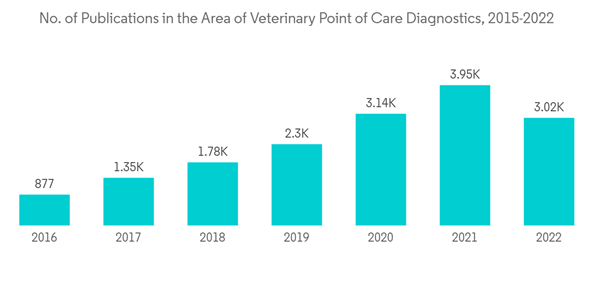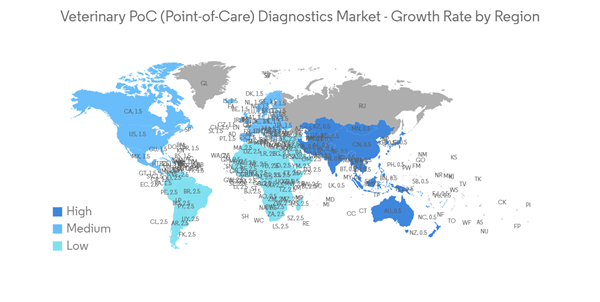The COVID-19 pandemic has initially had a slightly positive impact on the veterinary PoC (point-of-care) diagnostics market. At the onset of the novel coronavirus pandemic, a public lockdown was imposed. Due to the imposition of lockdown and social distancing, several factors led to a surge in pet adoption by people, which was helpful in getting rid of the loneliness and anxiety caused by isolation. As COVID-19 emerged from animals, the government, healthcare organizations, and media helped to raise awareness about the risk of zoonotic disease spread during the pandemic. The collective efforts of these bodies lead to increased knowledge of zoonotic infections, prevention, and hygiene for companion and livestock animals. Some of the leading companies operating in the veterinary PoC diagnostic market have witnessed mild growth in their revenues. For instance, IDEXX reported growth of only 3% from 2019 to 2020 and 27% growth from 2020 to 2021 in its veterinary, software, services, and diagnostic imaging systems segments.
Further, Zoetis reported revenue growth of only 7% from 2019 to 2020 and 16% growth in its revenue from 2020 to 2021 in its veterinary, software, services, and diagnostic imaging systems segments. In March 2020, IDEXX announced that it had found no positive results in pets with SARS-CoV-2. The company evaluated thousands of feline and canine samples to validate the new veterinary diagnostic test for the virus. This shows that the market for veterinary PoC has been mildly impacted by the pandemic, and the companies achieved robust growth in 2021. Thus, the COVID-19 outbreak had a mildly positive impact on the market's growth in its preliminary phase, with more pet adoptions and an increase in veterinary PoC testing. Moreover, the market is expected to grow further at a stable pace with the increasing demand for zoonotic disease diagnosis globally.
Furthermore, the increasing prevalence of zoonotic infections and their transmission to humans globally aided market growth. The market's growth is driven by the rising prevalence of zoonotic diseases and their transmission to humans, increasing pet adoptions and the number of veterinary healthcare professionals, and increasing research into veterinary disease diagnosis. According to a study published in the Faculty Reviews 2022, over 60% of the infections in humans have zoonotic origins, and over 40% of the infections have either emerged from non-zoonotic sources or co-evolved with humans. Recently, there have been several zoonotic-origin infections that resulted in an outbreak and have impacted the human population globally. Apart from the novel coronavirus, some zoonotic infections have recently impacted humans, including swine flu, Ebola, monkeypox, the zika virus, and others. According to the World Health Organization (WHO) 2022, there were over 130 reported cases of Ebola in the Democratic Republic of the Congo in 2020. On April 23, 2022, an outbreak of Ebola was declared by the health authority of the Congo. In July 2022, WHO declared the current monkeypox outbreak a public health emergency of international concern (PHEIC), overriding the WHO Emergency Committee. By November 2022, WHO had confirmed over 80,221 cases and 52 deaths from monkeypox in over 110 nations.
In addition, research in the area of effective diagnosis and monitoring of zoonotic diseases has been rising. The advancing research and use of veterinary PoC testing have helped in the management of antimicrobial resistance. According to the October 2022 issue of Acta Veterinaria Brno, the incoming advanced technologies in veterinary PoC include the development of microfluidics, lab-on-a-chip technologies, biosensors, bioanalytical platforms, complementary technologies, and others. Over time, PoC diagnosis contributes significantly to the monitoring of zoonotic diseases. As per the International Journal of Infectious Diseases 2021, current efforts are being made to utilize PoC for zoonotic diseases such as zoonotic tuberculosis (zTB), which accounts for 1.4% of the cases of global tuberculosis. Further, CRISPR-based technologies as a platform for zoonotic PoC testing are being researched. A study published in the journal Methods 2022 has highlighted the use of CRISPR Cas for diagnosis and point-of-care nucleic acid detection by using the Cas proteins (Cas3, Cas9, Cas12, etc.) to detect various infectious agents.
Therefore, owing to the aforementioned factors, it is anticipated that the studied market will witness growth over the analysis period. However, the high cost of veterinary imaging instruments will likely impede the market's growth.
Veterinary PoC (Point-of-Care) Diagnostics Market Trends
The Consumables, Reagents, & Kits Segment is Expected to Witness Significant Growth Over the Forecast Period
Consumables, reagents, & kits include the testing reagents, chemicals, plastic consumables, buffers, etc., used in the PoC diagnosis of animal samples. The rising demand for PoC testing consumables, reagents, & kits is driven by the increasing volume of diagnostic tests for zoonotic infections, cancer, and other chronic conditions. To meet the increasing demand for PoC testing, the emphasis on a continuous and elevated supply of consumables increased. For instance, in March 2022, Volition signed a supply and license agreement worth USD 28 million with Heska Corporation. Under the distribution, Heska’s Nu. Q Vet Cancer Screening Test would be commercialized for canine cancer screening and monitoring at the point of care. Further, in July 2022, the Life Science business of Merck KGaA was awarded funding support to produce lateral flow membranes, which are used in PoC tests for humans as well as animals. The funding of USD 123.7 million was provided by the U.S. Department of Defense of the U.S. Department of Health and Human Services.Therefore, the consumables, reagents, & kits segment is expected to witness significant growth over the forecast period due to the abovementioned factors.
North America is Expected to Dominate the Veterinary PoC (Point-of-Care) Diagnostics Market
North America is expected to dominate the market owing to factors such as the high number of veterinary patient visits, the developed veterinary healthcare infrastructure, and the advanced research and monitoring of veterinary diseases and therapies. According to a survey by VetSource 2021, veterinary patient visits are increasing. It was found that in 2019, 2020, and 2021, the number of companion animal patients per doctor witnessed a growth rate of 6% to 7.5% year-over-year.The presence of leading players is one of the factors driving the growth of the veterinary PoC (point-of-care) diagnostics market. Several leading players have undertaken key developments in the region. For instance, in May 2021, Advanced Animal Diagnostics announced an investment of over USD 7 million in developing its diagnostic platforms to support the One Health Initiative. The investment would help the company advance its platforms for the PoC test decisions to manage both animal and human health. Further, in July 2021, LightDeck Diagnostics signed a contract with the Department of Defense (DOD) and the Department of Health and Human Services (HHS) worth USD 35.1 million. Under the contract, LightDeck Diagnostics would elevate the manufacturing of the PoC COVID-19 test, which gives results in just 5 minutes. These continuous developments in the region are anticipated to drive the growth of the market in the country.
Therefore, owing to the advanced veterinary medical infrastructure and the key developments by the leading players, the growth of the studied market is anticipated in the North American region.
Veterinary PoC (Point-of-Care) Diagnostics Market Competitor Analysis
The veterinary PoC (Point-of-Care) diagnostics market is moderately consolidated in nature due to the presence of a few companies operating globally as well as regionally. The competitive landscape includes an analysis of some international as well as local companies that hold market shares and are well known, including IDEXX, Zoetis, Virbac, NeuroLogica Corp., and Heska Corporation. ESAOTE SPA, Merck KGaA, Woodley Equipment Company Ltd., Volition, Randox Laboratories Ltd., and AniPOC Ltd., among others.Additional benefits of purchasing the report:
- The market estimate (ME) sheet in Excel format
- 3 months of analyst support
This product will be delivered within 2 business days.
Table of Contents
Companies Mentioned (Partial List)
A selection of companies mentioned in this report includes, but is not limited to:
- IDEXX
- Zoetis
- Virbac
- NeuroLogica Corp.
- Heska Corporation
- ESAOTE SPA
- Merck KGaA
- Woodley Equipment Company Ltd
- Volition
- Randox Laboratories Ltd.
- AniPOC Ltd.










